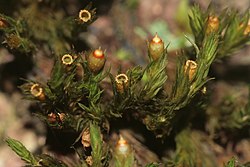| Orthotrichaceae | |
|---|---|
 | |
| Orthotrichum striatum | |
| Scientific classification | |
| Kingdom: | Plantae |
| Division: | Bryophyta |
| Class: | Bryopsida |
| Subclass: | Bryidae |
| Order: | Orthotrichales Dixon |
| Family: | Orthotrichaceae Arn. |
| Genera | |
See text | |
Orthotrichaceae is the only family of mosses in the order Orthotrichales. [1] [2] Many species in the family are epiphytic.